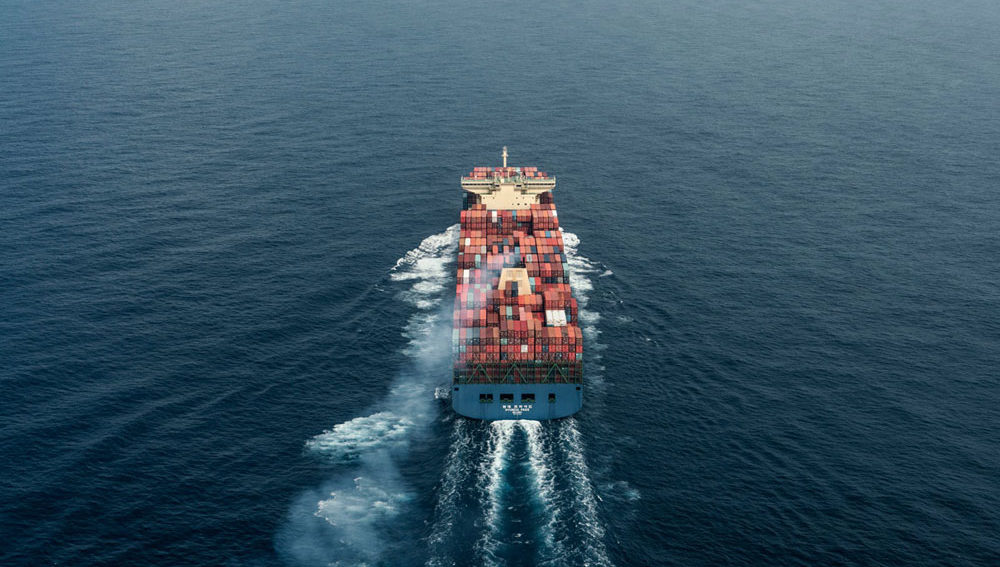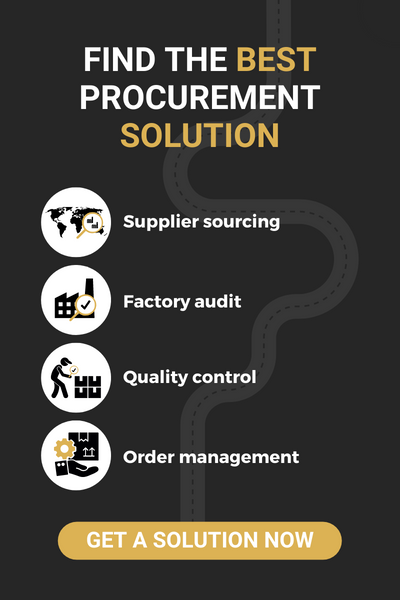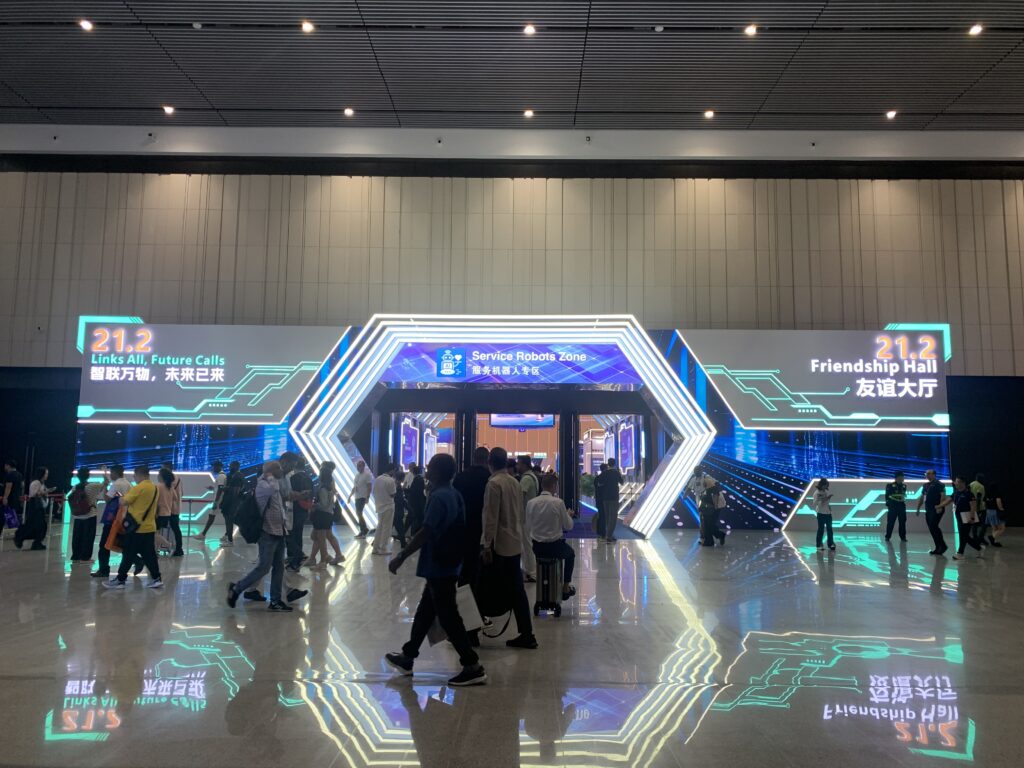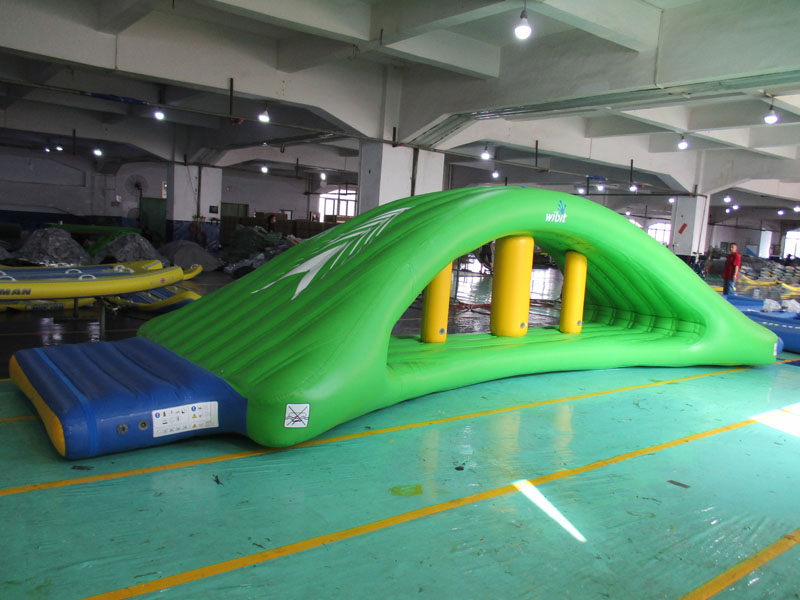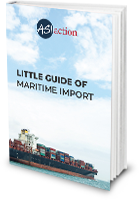Because the purchase in China can be enigmatic for beginner buyers, we have prepared this short & non-exhaustive guide that will clarify how international shipping works.
China is called the factory of the world for its variety of supply on every product. That’s why many companies turn to importing goods from China, but how to import from China?
You will learn about the actors, the standards, the documents, and the stages of the international transport process to import from China.
Players in the import from China
The freight forwarder
The international import and export of goods involves the use of different modes of transportation (air, road, sea, rail) and administrative and customs procedures to allow goods to move in and out of one customs area to another. These operations require the intervention of a qualified intermediary, such as a freight forwarder.
The freight forwarder takes care of the logistics of transporting the goods. Freight forwarders are simply intermediaries in the import from China. He takes all the necessary measures to deliver the goods properly and connects the different carriers to ensure the continuity of the customer’s supply chain.
The shipping company
A shipping company is a company that provides shipping services. Its role in importing from China is to allocate space on its ships. Shipping companies usually have a fleet that includes:
- Multipurpose cargo ships
- Container ships
- Barge carriers
- Bulk carriers
- Oil tankers
- Chemical tankers
Maritime transport is an attractive mode of transportation, notably :
- Its transport capacity: Hundreds of tons of cargo can be transported by a single vessel.
- Continuity of operations: On the water, there are few or no obstacles to transportation.
Customs
The role of customs is to control the entry and exit of goods on their territory. When you import from or export to a country outside the European Union, it is mandatory to declare your goods to customs.
All about shipping containers
Types and sizes of containers
General purpose shipping containers are the most common. It is also called a “dry” container because it is suitable for the transportation of so-called dry goods. Goods are usually loaded in crates, cartons, bags or pallets. DRY shipping containers are subject to international standards.
There are different types and sizes of sea containers for import from China:
- 20GP: maximum capacity of 33 m3*
- 40GP: maximum capacity of 67 m3*
- 40HQ ou HC: maximum capacity of 76 m3*
*theoretical volume available
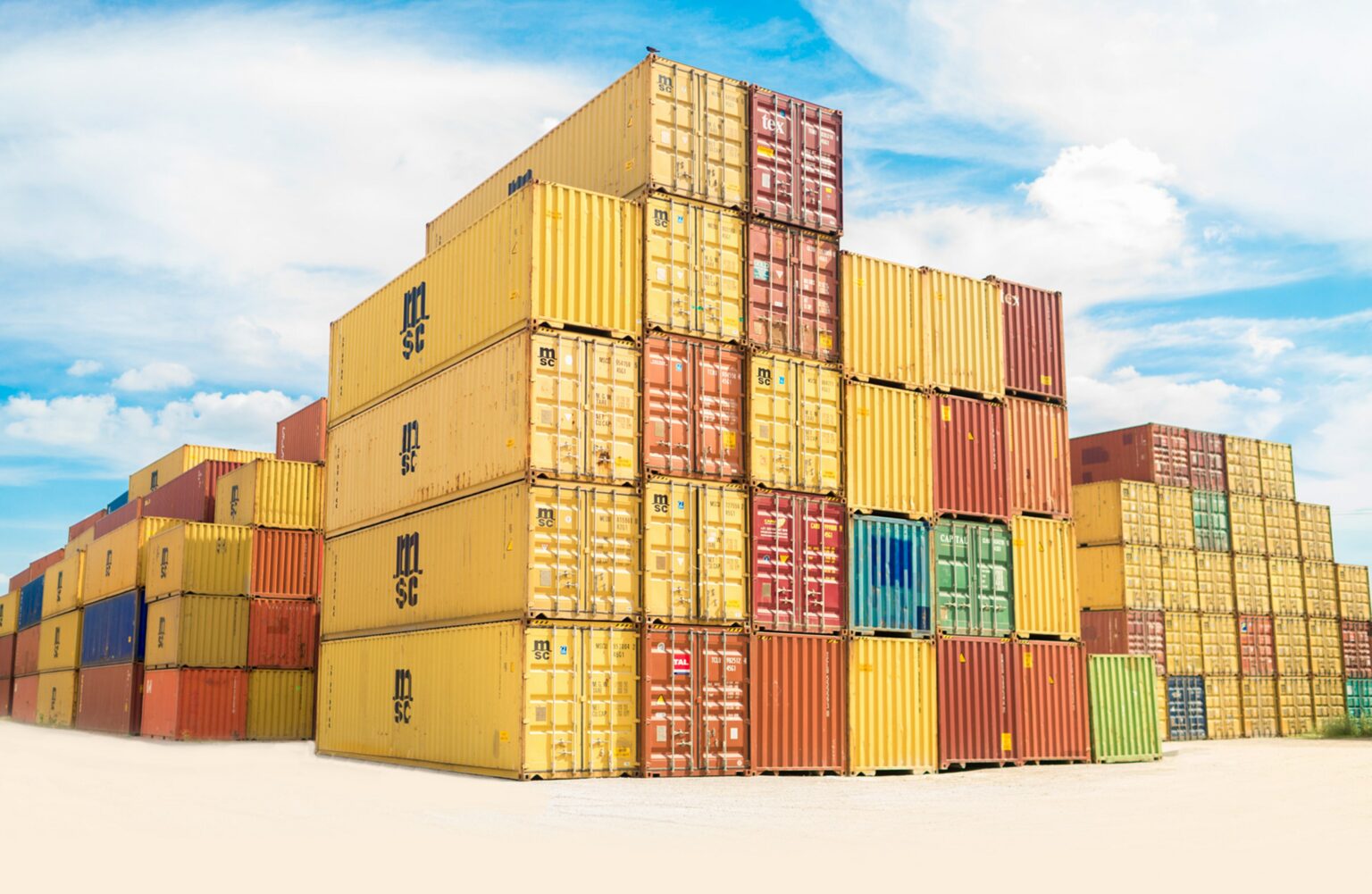
All you need to know about incoterms
Incoterms 2020 (International Commercial Terms) determines the mutual obligations of the seller and the buyer in an international sales contract. When a company buys a container of goods in China, it is usually sold FOB. Here we will see all the existing incoterms in the import from China.
Multimodal (adapted to containerized goods)
EXW - Ex Works (at the factory)
EXW is a rule that imposes the least obligations on the seller. The seller’s only responsibility is to pack the goods and make them available to the buyer at his premises. Under this rule, the buyer bears all costs and risks associated with loading the goods and transporting them to their destination.
In concrete terms, this means that if you buy your goods EXW, you have to pay the following costs:
- Loading of the goods in the factory or warehouse of departure on the means of transport
- Export customs clearance (duties and taxes)
- Pre-carriage (at port or airport)
- Loading of main transport at departure
- Main transportation (sea or air freight)
- Main transportation insurance
- Unloading of the main shipment on arrival
- Import clearance (duties and taxes)
- Post-carriage (factory or warehouse)
- Unloading (factory or warehouse) on arrival
For example, buying your goods at $1000 EXW Shanghai means that only the packing is included in the price, you still have to pay all the other costs.
FCA - Free Carrier
The seller delivers the goods to the consignee designated by the buyer according to the place of delivery:
- At the seller’s premises: the seller loads the goods into the buyer’s means of transport (FCA “seller’s premises”).
- At another location: The seller organizes the transportation of the goods to the loading location. There, the goods will be placed at the disposal of the carriers ready for unloading (FCA “Other agreed place”)
CPT - Carriage Paid To
The seller is responsible for transport to the agreed location, export clearance and possibly unloading.
CIP - Carriage and Insurance Paid to
The seller takes care of the transportation to the agreed location, is responsible for the export clearance and subscribes to an insurance on behalf of the buyer.
DAP - Delivered At Place
The seller assumes the risks and costs of transportation to the agreed location and takes care of the export clearance formalities.
This means that if you buy your goods in DAP, you will have to pay the following fees:
- Import customs clearance (duties and taxes)
- Unloading (in factory or warehouse) on arrival
DPU - Delivered at Place Unloaded
The seller bears all risks and costs of transport to the place of delivery and disposal to the buyer. Export clearance with the option of unloading is also included.
DDP - Delivered Duty Paid
The seller takes care of everything, including import clearance and payment of customs duties and taxes before delivering the goods to the buyer. The DAP Incoterm represents the maximum responsibility of the seller.
Concretely, this means that if you buy your goods in DDP, you only have to pay the following costs
- Unloading (in factory or warehouse) on arrival
Maritime - for bulk and conventional (not suitable for containerized goods)
FAS – Free Alongside Ship
The seller bears the transportation costs to the port of shipment and manages the export procedure. The goods will be delivered alongside the vessel at the port designated by the buyer. The FAS Incoterm requires the seller to clear the cargo for export.
FOB – Free On Board
The FOB incoterm is the most used in the sea import. It means that the price includes putting on the ship at the Chinese port. Once the container is on the ship, the goods belong to the buyer and are under his responsibility.
In simple terms, this means that if you buy your goods FOB, you have to pay the following costs:
- Main transportation (sea or air freight)
- Insurance of the main transport
- Unloading of the main transport on arrival
- Import customs clearance (duties and taxes)
- Post-carriage (factory or warehouse)
- Unloading (factory or warehouse) on arrival
CFR – Cost and Freight
The seller is responsible for shipping costs up to delivery on board, and assumes the costs associated with main transportation, and export customs clearance.
CIF – Cost, Insurance and Freight
Like the CFR Incoterm, the seller takes care of the main transport, the export clearance. The only difference is that the seller subscribes to an insurance on behalf of the buyer.
In other words, if you buy your goods in CIF, you have to pay the following costs
- Unloading of the main means of transport on arrival
- Import customs clearance (duties and taxes)
- Post-carriage (factory or warehouse)
- Unloading (in factory or warehouse) on arrival
The main stages of maritime transport
From the Chinese factory to the warehouse at destination
Concretely, we present you the main steps of the maritime transport for an importation from China.
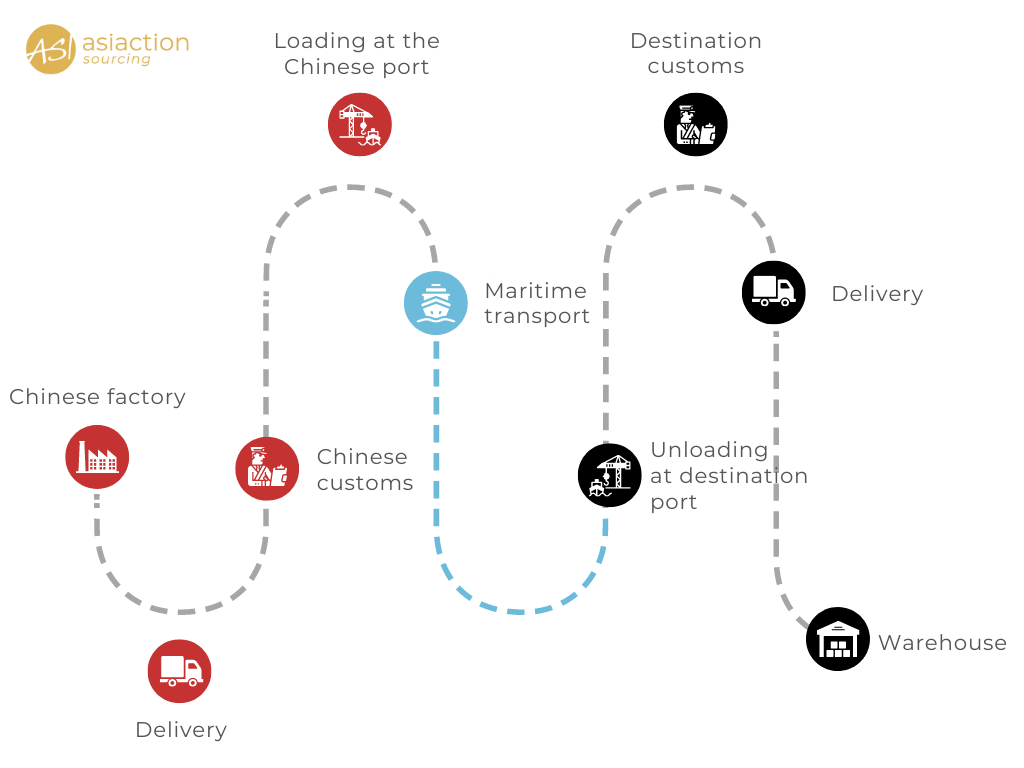
Import procedures from China
Documents required for import
In order to import goods from China, you will need specific documentation to validate the entry of the goods into the country.
- Bill of lading (BL): The bill of lading is the transport document used by sea. It is used to prove the condition of the goods upon receipt and delivery by the carrier. It proves the existence of a contract of transport.
- Commercial Invoice (CI): The commercial invoice contains important export information, including allowing you to calculate customs duties and other taxes paid after the goods arrive at your destination.
- Packing List (PL): The packing list is used to identify shipping packages by number and provide aggregate data such as weight, volume and number of packages.
- Test reports, certificates of conformity, certificates of origin, etc.
For the European Union
To import from China, the EORI registration is a mandatory step before any customs operation in a European Union Member State. The EORI number (Economic Operator Registration and Identification), established as part of a system to secure trade with the European Union, is unique and allows the identification of each economic operator in transactions with customs authorities.
You will need your EORI number in the following cases:
- Import and export of goods outside the European Union
- Submitting, modifying and updating applications for action to protect your intellectual property rights (counterfeiting)
Outside Europe
Contact us for instructions on the import process in your country or region.
Import China: taxes to be paid on import
Customs duties
Customs duty is a tax on imported goods. It is applied when the goods cross the border. As a rule, customs duties are only paid at the time of import. However, some countries have export obligations. Customs fees depend on the product. Companies that want to sell their goods internationally need to know the tariffs of the country to which they are exporting.
The amount is calculated on the value: Price of the product + price of transportation to the port of arrival.
VAT
VAT is charged on the importation of goods.
Since January 1, 2022, VAT is compulsory and automatically self-liquidated for all companies identified for VAT and certain public institutions in France.
The amount is calculated on the value: Product price + transport cost + customs duties.
Outside Europe
Contact us for instructions on how to pay VAT in your country or region.
Common mistakes when importing from China
By following this guide you already have a good overview of the process of an import from China and the indicators to take into account. However, you can never be sure of certain mistakes, that’s why we have gathered 3 common cases encountered during the importation process.
The factory cannot export so the customer has to buy EXW. He doesn't know how to organize export from abroad.
It happens that some suppliers do not have the right to export and therefore sell EXW. This means that the buyer has to organize everything from his country, which is difficult when you are not on site. That’s why it is very important to be informed about the responsibilities of the chosen incoterm and to consider the total handling of the goods.
As we mentioned above, buying goods under the EXW incoterm means that the seller has the least obligation since he only has to pack the buyer’s goods and make them available in his warehouse. The buyer has to organize everything on his own in order to export his packed goods from the seller’s premises to his home.
In this situation, we recommend you to use an agent in China like Asiaction able to manage everything for you. You will be able to optimize your costs and secure the supply of your goods to your destination.
Lack of information on the customs duties in place, so the customer ends up with taxes that he had not considered in his margin.
Another example of a topic we mentioned in the previous section: import taxes. It is essential to be well informed about the customs duties on your merchandise, otherwise you will have surprises on arrival.
It is frequently the case that buyers do not know the import duties on their products and end up with a tax to pay that they had not taken into consideration in their total cost. The extra tax affects the resale margin they had already concluded so it is either reduced or ruined.
Avoid extra charges and find out about taxes before you import!
If you are a European importer, you can check the HS Code, the duty rate on the TARIC system.
For US importers, you can find the HTS codes on the Harmonized Tariff Schedule site.
A buyer ships LCL with the CIF incoterm and is charged with unexpected handling and storage charges on arrival.
Finally, the last situation, which is more particular but often encountered, is the case of additional costs for storage and handling in LCL (Less than Container Load) shipments. LCL is reserved for small volume orders since the principle is to group the shipments of several customers in a shared container.
It is important to know that with an LCL shipment, there is not much control over the process and the costs on arrival are often higher than expected. You have to include the opening of the container at the port of arrival, the unloading, the storage and the dispatching of the different orders for the final delivery.
Specifically, if you are buying a small volume of goods in China, you will be sending in LCL. Some suppliers offer CIF for small volumes. In this case, you may end up with charges for unloading and storage because the warehouse on arrival is chosen by the seller’s forwarder.
You need to know what these charges are before you accept the vendor’s offer.
Alternatively, you can increase your order volume to make a FCL (Full Container Load) shipment. With FCL, no unloading is required, so you avoid all these additional costs.
Conclusion
With this short guide to importing from China, you already have an idea of what to expect. We remind you that documentation and taxes vary from one country to another and that it is therefore important to be particularly informed before importing your products from China.
Note that there are purchasing offices to support you and secure your supply in China.
If you are looking for a sourcing agent, ASIACTION is your expert of the purchasing process in Asia since 2008. Contact our experts and make your purchasing project in China a reality.

